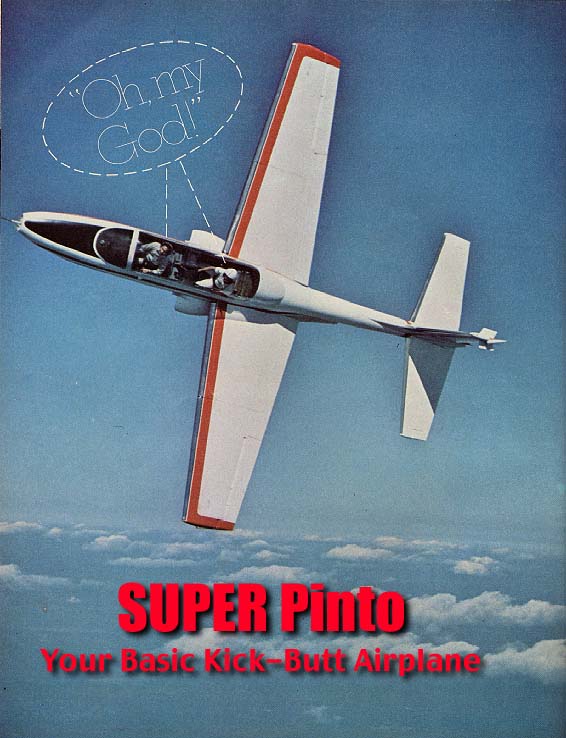

There are very few airplanes around these days that fall into the Oh-My-God category. There are lots of Ho-Hums, a few Nifties and your first ride in a Pitts is good for a healthy Gheezus, but there are precious few flat-out, Oh-My-God airplanes. A Mustang certainly doesnt make it and a Lear jet doesn't. A Bearcat is right up there with the Pitts. However, if there was ever an airplane that can reach in and grab your guts, forcing out a healthy "Oh, My God," the Temco TT-1 Super Pinto is it...in spades!
Right this instant, someone out there is saying, "Great, the Pinto is a super machine...now, what the hell is a Pinto?" The Temco Pinto was originally built to try for a Navy trainer contract in the early 1960's. That's what it was. What it is, today, is a SUPER Pinto, and believe me, the "super" has to be in all capital letters to even begin to convey the difference between the Pinto and a SUPER Pinto.
Only 14 TT-1 Pintos were built and they used a US-built version of the French Turbomeca Mabore engine. We called it the J-69 and the Cessna T-37 used two of them. It put out about 930 pounds of thrust, was of the old centrifugal flow design, and was excellent for melting snow on runways and not much else. With only one of those engines, the Pinto had everything it could do to hop over tall alligators during its evaluation test flights in Pensacola.
All but one of the surviving airplanes flying today has been re-engined with the GE J-85, a military version of the CJ-610, the engine used on Lear Jets, which pumps out just short of 3,000 pounds of thrust. This is where the Oh-My-God comes from. By tripling the power, reducing the airframe weight and by making slight airframe mods, the present owners have the most incredible airplanes on the civilian registry.
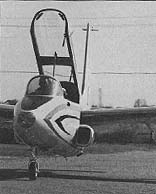 Steve Snyder is one of those lucky
owners. Snyder, Chairman of the Board for Para Flite, Inc., the
world's largest manufacturer of sport parachuting equipment, likes
exciting hardware. (Editor's Note from the year 2000: We lost
Steve in an F-86 accident in 1999, a good friend, we miss him
mightily). He was looking for an outstanding airshow machine,
so when he met Frank Guzman, the man best known for his Super
Pinto work (American Jet Industries' Al Paulson also worked with
Pintos to sell as COIN fighters), and heard how Guzman had engineered
and made all the modifications on his Pinto he asked if Guzman
could set one up for him. He would and he did, and many bucks
later, Steve Snyder was out amazing himself and every crowd in
sight with his new airshow machine.
Steve Snyder is one of those lucky
owners. Snyder, Chairman of the Board for Para Flite, Inc., the
world's largest manufacturer of sport parachuting equipment, likes
exciting hardware. (Editor's Note from the year 2000: We lost
Steve in an F-86 accident in 1999, a good friend, we miss him
mightily). He was looking for an outstanding airshow machine,
so when he met Frank Guzman, the man best known for his Super
Pinto work (American Jet Industries' Al Paulson also worked with
Pintos to sell as COIN fighters), and heard how Guzman had engineered
and made all the modifications on his Pinto he asked if Guzman
could set one up for him. He would and he did, and many bucks
later, Steve Snyder was out amazing himself and every crowd in
sight with his new airshow machine.
The basic airframe, besides being modified to mount the J-85 blow torch, now sports a slightly different airfoil, semi-wet wings, highly modified intake ducts, new hydraulics, a different canopy system, and of course, new black boxes and instruments. What it ought to have is some sort of internal system to equalize the instant jet lag all who fly the airplane experience; it quite literally puts you in an entirely different dimension of flight and boggles the mind with its ability to boogie.
Something over ten years ago, I used to spend a lot of time sitting in a Pinto. It was bright and shiny new, with not a scratch on it. The Navy certainly took good care of it. I would clamber over the side, slide down into the seat and carefully adjust the pedals for my leg length. Then I'd pull the canopy down and play fighter pilot. Unfortunately, I actually was "playing" because this particular airplane's engine had been removed and the castrated airframe was sitting in one corner of the aero-engineering hangar where I went to school (don't bother calling, I already have and it's gone). I knew the Temco Pinto well: How it looked, how it felt, even how it smelled. What I didn't know was how it flew.
Flash! It's ten years later and I'm back sitting in a Pinto again. This time, however, there's a couple of minor differences. First of all, I can hear the kerosene burner screaming away behind me, secondly. I can see Harry Shepard's helmeted head in the little rear view mirror above me we're sitting at the edge of the runway, and it's pretty damned obvious that this time I'm not playing. This is for real.
Harry Shepard, best known as the wingman in the WACO Meteor formation team, has the enviable position of performing as airshow pilot for Snyder's Super Pinto. Snyder supplies the airplane and Shepard supplies the talent . . . and puts on one incredible airshow. Any takers? This trip, he lost the toss and was to be the one to check me out, or at least try to check me out, in Snyder's machine. Obviously, Snyder is your basic trusting soul.
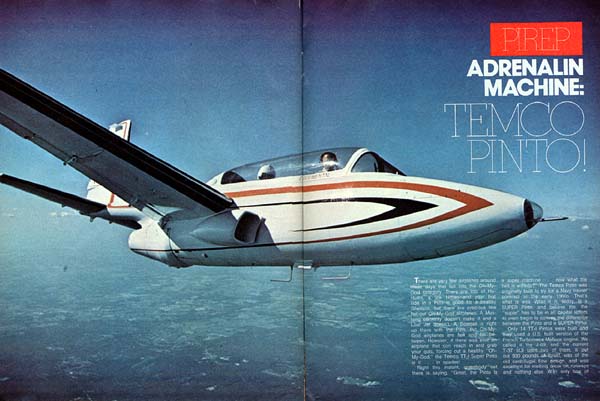
I had watched Harry's airshow a number of times and I was particularly impressed with what he did with the airplane when it was slow. He, for instance, rotates on takeoff and immediately racks it around in an incredibly tight 360 degree turn right on the deck with the gear still coming up. Those big square wing panels and its fat airfoil let him do things at speeds most other jets use for straight and level only. When giving me the ground check, he mentioned that the airplane had plenty of lift and at slow speeds the controls had almost no feel, so it was easy to over-rotate on takeoff. I kept that in mind as I awkwardly jinked my way out to the centerline of the runway.
From start to finish, I cursed the brakes on the airplane because they had a lot of bleed-down and were very grabby. Since I had to depend on them for steering, I jerked right and then left, then right again trying to center the nose on the runway. Quite honestly, the prospect of keeping a jet aimed down the runway with brakes like that didn't exactly make me giggle with delight. It turns out I didn't have to worry.
Most jets are deceptively simple, and the Pinto was even more so. Once the canopy was locked down, the trim set, all that was left was to move the throttle forward and go flying. And it happens a whole lot faster than it takes to tell about it. Most jets have a certain amount of lag caused both by the inertia of the airplane and the spool-up time of the engine. Well, you can forget about that with a Super Pinto. I moved the throttle forward fairly slowly and smoothly, so the engine was keeping right up with the throttle, and I barely had full power before we were in the air. I had been extremely careful on picking the nose up and was a little traumatized to find that Harry was right, there was absolutely no stick feel at that speed. As soon as the nose was off the runway, the airplane hesitated for a brief second and leaped off. The acceleration during all of this was as fast as I've ever experienced in anything, including drag racers.
I guess it was as much instinct as anything else that I leaned forward with my left hand and yanked the gear up before the airspeed went off the clock. Keeping a moderate nose angle, we had 200 knots at the end of the runway and 230 knots a second later! I pulled the nose up to keep to a climb speed of 200 knots and simultaneously the ground disappeared, as if it was yanked out from under me. The initial rate of climb was something like 10.000 fpm! Absolutely unbelievable!
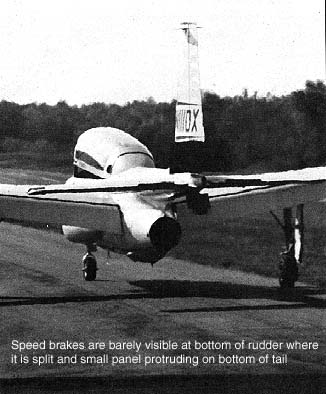 It's difficult to actually "sense"
performance in an airplane. Usually you tend to know an airplane
has good or bad performance because of what the gauges are telling
you. But that's not the case with the Pinto. The climb is so rapid
that it actually pins you down like an express elevator and the
visual sensation is so obvious that it's almost disorienting.
Just a gentle tug on the stick to change nose attitude and the
horizon drops out of the edge of your peripheral vision. The airplane
only weighs about 5,000 pounds at gross and has lots of wing,
so it's one climbing machine.
It's difficult to actually "sense"
performance in an airplane. Usually you tend to know an airplane
has good or bad performance because of what the gauges are telling
you. But that's not the case with the Pinto. The climb is so rapid
that it actually pins you down like an express elevator and the
visual sensation is so obvious that it's almost disorienting.
Just a gentle tug on the stick to change nose attitude and the
horizon drops out of the edge of your peripheral vision. The airplane
only weighs about 5,000 pounds at gross and has lots of wing,
so it's one climbing machine.
We went banging through 10,000 feet while my mind was still trying to figure out how to get out of the pattern. As I pushed over into level flight, I asked Harry what power setting to use for cruise and he told me to use whatever it took to keep us under 310 knots lAS the red line. Amazing! As soon as we were level, I started making turns right and left to try and figure out where we were. At those numbers, the countryside goes by in a hurry. Not only is it moving fast, but it looks a whole lot different from that high up.
The one thing that I kept constantly on the back of my mind and, if I didn't, Harry kept reminding me, was the fuel supply, such as it was. Trainers were never intended for long cross country flights and this one wasn't built for a J-85 either. So, the effective duration is less than 2 hours under optimum conditions and frolicking around at 10,000 feet was hardly optimum. The J-85 burns 80-100 gallons an hour at cruise and 500 gallons at takeoff power, and a little digital counter on the instrument panel keeps you constantly advised how much you have left, which is never enough. Snyder is currently working on various ways of wedging more fuel into the machine to give it a decent range.
Probably the most difficult thing for me was simply holding a constant altitude. The tiniest tweak on the stick is good for 1,000 feet. The first time I pulled the nose up for a roll, we touched 14,000 feet before I knew what was happening. The electric trim system on the top of the stick makes it easy to change trim, but even so, I never got the Pinto into a groove so that it would hold altitude by itself. I had to stay on top of it constantly. Also, since it was burning so much fuel, it would pull a little out of one tank faster than the other and I'd have to trim a wing up. Ah, but such minor aggravations for such major delights.
At 290 knots, you can suck the nose straight up, wrapping the stick to one side and go spiraling up out of sight. Although the roll rate isn't as quick as most jets, it's still damned good and the stick pressures are light and quick. It has the ultimate in low speed manners for a jet, so you can let the speed bleed off on the top of a vertical roll until it falls through 100 knots, and gently pull it over the top while it's still decelerating. It will roll as long as you are willing to hold the stick to one side. One could go blasting cross country at an indicated 275 knots at reduced power and never once stop slow rolling, if that's what you're into. Its loops can be as big as you please or as little as you are willing to pull, so long as you ease off on the top. But Harry showed me an even more amazing thing by doing a split-S from 180 knots and only using up 1,800 feet of altitude. Dirty, it will do the same thing in 1,200 feet.
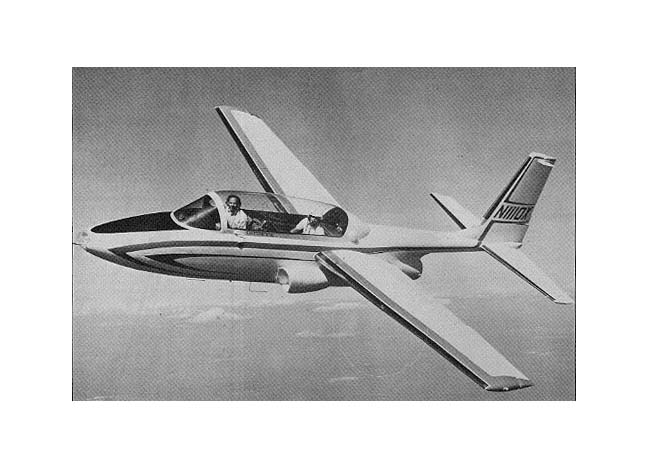 A flight in the
Super Pinto added significantly to the sizeable respect I already
had for Shepard's ability as a pilot. The Pinto is an airplane
that has almost too much performance, if there is such a thing.
For Shepard to be able to keep the maneuvers framed right in front
of a crowd and keep them all within sight, requires a very talented
set of hands. The problem in the Pinto is that it accelerates
so rapidly under power that keeping it low and within sight ain't
easy. So, most of Shepard's show is done either under partial
power or completely power off. The speed brakes on the airplane
are only a small flap under the tail and the bottom portion of
the rudder which splits and opens out into the wind on both sides.
Although the speed brakes help, they are limited to 200 knots
and you can't even tell they are there when the power is screwed
down.
A flight in the
Super Pinto added significantly to the sizeable respect I already
had for Shepard's ability as a pilot. The Pinto is an airplane
that has almost too much performance, if there is such a thing.
For Shepard to be able to keep the maneuvers framed right in front
of a crowd and keep them all within sight, requires a very talented
set of hands. The problem in the Pinto is that it accelerates
so rapidly under power that keeping it low and within sight ain't
easy. So, most of Shepard's show is done either under partial
power or completely power off. The speed brakes on the airplane
are only a small flap under the tail and the bottom portion of
the rudder which splits and opens out into the wind on both sides.
Although the speed brakes help, they are limited to 200 knots
and you can't even tell they are there when the power is screwed
down.
Before bringing the airplane back into the pattern for a couple of landings, I tried a stall series and got an inkling of what it was like slow and dirty. For one thing, it doesn't decelerate worth a damn. The easiest way get it slowed down is to chop the power, yank it into a tight, high g turn, throw out the speed brake, when it's slow enough, and get the gear at 160 knots. Once it's dirty, it flies pretty much like any other extremely high powered airplane except that its stalls are much nicer. Straight ahead, it trucks right on down to around 65 knots before buffeting, rocks its wings and then lets go with a gentle roll in one direction or the other. In an accelerated stall in a turn, it just pitches over the top to the outside of the turn like a good little airplane. Nothing treacherous there!
Since we were already slow, I just brought the gear up and left the boards out as we went down hill to enter the pattern. It's funny, but to a bug smasher driver like me, 10,000 feet seemed really high, but as we came back down to 1,000 feet, it felt like we were right in the tree tops.
As we entered the pattern, I made a special note to keep a good chunk of airspace between me and the Cherokee traffic ahead. I figured Snyder wouldn't want me scarfing one into the intakes on my first flight, although it will mix with training traffic with no problems. Gear down, flaps out one notch on downwind and the terrifying performance disappeared and the Pinto became just another airplane, albeit one with extremely light controls. Luckily the control travel is relatively long, so the lightness doesn't necessarily translate as "sensitive."
Slow, dirty and trimmed, the Pinto will hold exactly the speed you ask of it indefinitely. Which is lucky, because on my first turn to final, I overshot the turn and had to do a little jockeying around to get lined up on final. Embarrassing, I might add, but I noticed on my second approach that sitting so far forward in the airplane with no wings, no nothing, in your vision tends to throw your judgment off slightly. Well, it sounds like a reasonable excuse, anyway.
On final, I held 90 knots and used whatever power was needed to keep the numbers stationary in the windshield. It homed in on the runway numbers and I chopped the power just as I began to flare, holding it off until I was only a foot or so off. Then, since Harry said it had so much residual thrust it wanted to float forever, I eased it down as gently as possible. The resulting "thud" was a gentle one and I kept the nose up as long as the elevators felt solid, easing the nose down only when it looked like I was about to run out of elevator. Incidentally, lowering the nose to the runway scared me for a second because the nose is so low in relation to the pilot that for a brief second I thought the nose gear had-folded and I was going to get to do another of my sliding-on-my-nose-to-a-halt routines.
I had already made a deal with Harry that he'd handle the brakes, so I wouldn't come to a jerky halt like a side-winder with rheumatism. So after we'd made a couple of go arounds (with the power on, you can't tell the gear, speed brakes and flaps are even there), Harry snubbed us to a halt and we headed back to where Snyder was being very careful to look casual and nonchalant.
The Super Pinto has to be one of life's true pleasures. It
is a show machine which converts kerosene and money into adrenalin
and grins better than any airplane ever built. Even though the
expense of such a hotrod is far, far beyond the vast majority
of us tire-kickers, it's still nice to know that there is somebody
willing and able to play that game, so we can at least salivate
over the airplane at airshows. Without them, dream machines wouldn't
exist and without dream machines, what are dreams?